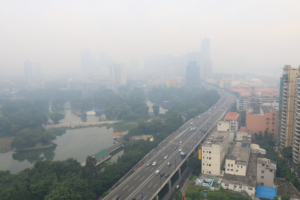Polluted air is shortening lives around the world
Written by Olivia Nater | Published: September 5, 2023
New data reveal particulate air pollution increased in 2021 as a result of population growth and industrialization, and still represents the greatest environmental threat to human health globally.
According to the World Health Organization (WHO), 99% of the global population breathes air that exceeds WHO safety limits. The University of Chicago just published its Air Quality Life Index (AQLI) Annual Update, which shows that reducing fine particulate pollution (PM2.5) to the safety guideline of 5 micrograms per cubic meter (μg/m3) would add an average of 2.3 years to people’s life expectancy.
An invisible killer
PM2.5, which originates mainly from fossil fuel combustion, is a particularly harmful air pollutant as its small size allows it to penetrate deep into the lungs and enter the bloodstream, damaging cardiovascular, cerebrovascular, and respiratory health.
The report states that the impact of fine particulate pollution on life expectancy is comparable to that of smoking, almost four times higher than that of alcohol use and unsafe water, almost six times as high as the impact of traffic accidents, and nearly eight times that of HIV/AIDS.
The most polluted countries
Due to their high pollution levels and large populations, the six worst affected countries account for as much as three-quarters of the global health burden in terms of total life years lost. In descending order of pollution level, these are Bangladesh, India, Pakistan, China, Nigeria, and Indonesia. All six countries are among the world’s eight most populous nations.
In Bangladesh, citizens are losing on average 6.8 years of life due to unhealthy air, while India alone is responsible for around 59 percent of the global increase in air pollution since 2013, according to the report.
 China is fortunately moving in the right direction — the report notes that it has achieved a 42.3 percent pollution reduction from 2013 to 2021, extending average life expectancy by 2.2 years. Particulate pollution in China is still six times the WHO guideline, however, with Chinese citizens losing an average of 2.5 years of life. The fact that China’s population recently stopped growing puts a clean air future within easier reach.
China is fortunately moving in the right direction — the report notes that it has achieved a 42.3 percent pollution reduction from 2013 to 2021, extending average life expectancy by 2.2 years. Particulate pollution in China is still six times the WHO guideline, however, with Chinese citizens losing an average of 2.5 years of life. The fact that China’s population recently stopped growing puts a clean air future within easier reach.
The other five countries are still experiencing rapid population growth — even India, which achieved replacement level fertility in 2020, is projected to continue growing until the 2060s due to population momentum. Population increase combined with these countries’ economic development trajectories means air quality will continue to deteriorate unless environmental regulations and efforts to phase out fossil fuels are strengthened.
The report states that while media attention related to poor air quality is usually focused on Asia, Central and West Africa also have emerging pollution hotspots. The remaining four countries making up the 10 most polluted countries in the world are the Democratic Republic of the Congo (DRC), the Republic of the Congo, Rwanda, and Burundi. In these nations, average PM2.5 levels are six to seven times the WHO guideline and reduce life expectancy by up to three years.
The situation in the U.S.
In the United States, the PM2.5 level is 1.6 times higher than the WHO guidelines, which equates to a life expectancy loss of 3.6 months. Pollution legislation such as the Clean Air Act helped achieve a 65 percent reduction in fine particulate matter since 1970, extending lives by 1.4 years.
 Nevertheless, 96 percent of the U.S. population is still exposed to unsafe air, according to WHO standards, with vast differences between areas. For example, the rise in record-breaking wildfires in California’s Central Valley have caused local particulate matter pollution to regularly far exceed the WHO safety level. In 2021, PM2.5 levels in Plumas County, the most polluted area of the U.S., averaged 26.6 μg/m3, meaning residents are losing 2.1 years off their lifespans. Overall, 20 of the 30 most polluted U.S. counties in 2021 were in California. The second and third most polluted states are Indiana and Illinois, respectively.
Nevertheless, 96 percent of the U.S. population is still exposed to unsafe air, according to WHO standards, with vast differences between areas. For example, the rise in record-breaking wildfires in California’s Central Valley have caused local particulate matter pollution to regularly far exceed the WHO safety level. In 2021, PM2.5 levels in Plumas County, the most polluted area of the U.S., averaged 26.6 μg/m3, meaning residents are losing 2.1 years off their lifespans. Overall, 20 of the 30 most polluted U.S. counties in 2021 were in California. The second and third most polluted states are Indiana and Illinois, respectively.
Inadequate response to global air pollution crisis
International funding for air pollution reduction is severely lacking. The report points out that the Global Fund to fight HIV/AIDS, malaria, and tuberculosis annually disburses $4 billion, but there is no equivalent coordinated effort to tackle air pollution, despite its high global health toll. Less than $300,000 per year in philanthropic funding goes to Africa to improve air quality, and just $1.4 million goes to Asia, outside of China and India.
Another area where increased funding is desperately needed is international family planning. Global expenditure is billions of dollars short of what is needed to satisfy unmet contraceptive needs and slow population growth, which would alleviate the health burden of all environmental issues, including air pollution. Wealthy nations must step up investments in global health and sustainable development efforts in poorer regions so that low-income countries can enjoy economic growth without compromising the health and lives of the people who live there.

